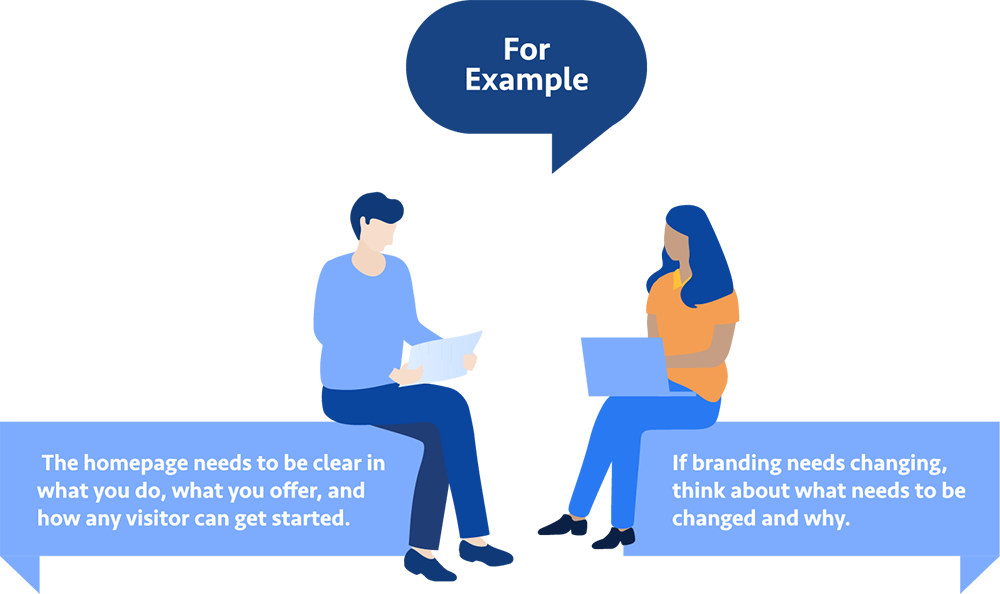Whether you’re looking to increase site traffic or give your visitors a revitalized navigation experience, our guide will cover the essential steps to take for a successful website redesign.
Website redesign projects do not happen by magic, which means planning and strategy will be required before diving right into the nitty-gritty.
If you’ve contemplated redesigning your website, chances are you’ve already noticed some things you’d like to change. Even so, it is important to understand how changes impact the overall website.
Each step of the website redesign has its own unique purpose which will allow you to achieve the following:
- Step 1: How to benchmark website performance
- Step 2: Determine website redesign goals
- Step 3: Define your branding messaging strategy
- Step 4: Creating B2B buyer personas
- Step 5: Protect your search engine optimized pages
- Step 6: Compare your website with competitors
- Step 7: Take inventory of your high-performing content
- Step 8: Choose the right software
One of the most important aspects of any B2B marketing strategy is website design.
When visitors arrive at your website they should find compelling content, appealing visuals, in a structured format where branding is conveyed throughout the site. A well designed website offers a satisfying experience that inspires visitors to take action.
Step 1: How to benchmark website performance
Benchmarking your current website’s performance metrics will give you a clear starting point to compare and contrast how effective your new web design is compared with your old one.
We recommend starting by looking at your monthly performance metrics to understand the amount of engagement that occurs on your website. Some of the most common metrics to look at would be the number of visits, visitors and unique visitors, however.
In order to establish a successful benchmark it is essential to look at additional factors that contribute to your website’s performance. We recommend the following metrics listed below for your monthly performance analysis.
- Number of visits, visitors, and unique visitors
- Bounce rate
- Time on site
- Top-performing keywords in terms of rank, traffic, and lead generation
- Number of inbound linking domains
- Total new leads and form submissions
- Total sales generated (in dollars)
- Total pages indexed
- Total pages that receive traffic
Step 2: Determine website redesign goals
Setting goals and making sure they are tied to measurable results should be the first step in your B2B website redesign project plan. The quality of your website influences the decisions people make when they visit. There is not an exact science to web development that says, ‘you need a new website’ but there are some important factors to keep in mind as you assess the quality of your website. Remember, the goals of website redesign should always be tied to measurable results.
If you’re looking to increase the number of visitors who reach your website some factors to consider for your website goals are listed below:
- Increase the number of visits and visitors
- Reduce bounce rate
- Increase time on site
- Improve domain authority
- Increase the total new leads and form submissions
- Increase the total sales generated
- Enhance current SEO rankings for important keywords
Step 3: Define your branding messaging strategy
Set the tone for an enjoyable navigation experience for your visitors with consistent branding and authoritative marketing content. Often, the first thing that comes to mind when thinking about branding is a clean professional presentation.
The cohesion between the brand and the message should be seamless. Your visitors should feel compelled to take action because they trust what you do and how you do it.
Value propositions speak to the needs and desires of your audience where you communicate the benefits your company has to offer. Avoid the common mistake of bragging about how great your company is; frankly your visitors will feel less compelled to engage because you haven’t told them how you’ll help them.
- For example, the homepage needs to be clear in what you do, what you offer, and how any visitor can get started
- If branding needs changing, think about what needs to be changed and why

Step 4: Creating B2B buyer personas
Speaking the language of your prospects sounds easy enough right? Tell them all the great things about your company’s achievements to get your visitors interested. Well, there’s a little more to it than that, because what people really want to know is how you can help them, which starts with creating b2b buyer personas.
A well defined buyer persona should speak directly to the needs and desires of your prospects. You should make an effort to put yourself in their shoes to communicate a message that inspires them to act because it focuses on their needs.
While it is certainly a good strategy to highlight your company’s achievements to strengthen credibility, speaking the language of your prospective customers is what will transform uncertain website visitors into eager prospects who see you as the solution to their need.
- Think from your prospects’ point of view: “What’s in it for me and how could this help me?”
- Speak to your personas in their ideal language
- See what a well defined buyer persona looks like here.
Step 5: How to maintain SEO rankings
Website redesign and SEO will be critical to maximizing your digital marketing efforts. If you’ve noticed substantially less traffic to pages that typically receive significant engagement, there is a strong likelihood that you’ll need to update your keyword targeting.
Keywords are how people find your landing pages when they search online for something. Thinking strategically about how buyers would search for a solution like yours will help to increase website traffic and engagement from your audience.
On page SEO is a good place to start to safeguard your site and generate more leads for your organization.
Listed below are some On-page SEO tips to keep in mind as you build out your new site design:
- Quality content
- Title tag
- Headers
- Meta description
- Proper formatting
- Internal linking
- Mobile functionality
- Well-composed URL
- Website Speed
Step 6: Compare your website with the competition
In order to understand where you can set yourself apart from the competition, first you need to understand the competition. Starting with a website competitor analysis can also help you identify trends and best practices in your industry.
Once you learn what they do well and where they are lacking, you can craft your marketing strategy to capitalize on what contributes most to your success.
Researching your competitors starts with taking a look at their website and social media platforms to see where people are spending their time.
Doing a competitor website audit is a great way to learn about the competition and what they do well, while providing you with insight into industries that overlap.
Step 7: Create a website content inventory
In order to direct visitors to your best performing pages, it is important to know which pages are receiving the most traffic. Creating a website content inventory of your best performing pages will give you valuable insight about what your visitors are actually interested in reading about.
Conducting a content audit is one of the most effective strategies to learn how to produce more content your audience will love. Instead of guessing and wondering what pages are performing best Google Search Console can help you identify your top pages and opportunities you might be missing.
Some examples of a high-performing content:
- Most-shared or viewed content
- High-traffic pages
- Best performing or ranking keywords and associated pages
- Repurpose high-performing content into infographic, slideshow, or video
- Consolidate short articles into whitepaper or long form article
Step 8: How to choose the right CMS
Choosing a cms platform to build your website will save you time down the road. First, you’ll want to have software that you are comfortable using. This means making sure your website has publishing functionality that allows you to easily create, publish, and optimize for search engines.
Common factors to consider for CMS software below:
- Pricing
- Support & customer experience
- SEO
- Personalization
- Security
- Functionality
Conclusion
Now that you know the steps it takes to create a winning B2B website redesign project plan, your focus should shift to execution. This means being realistic about what you can commit to doing on your own and where you may need some additional support.
If you’ve thought about seeking support to help with the redesigning of your website, EBQ’s designers and developers can help.


